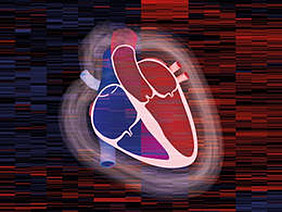A team of researchers from Munich compiled the first protein atlas of the healthy human heart, the so-called cardiac proteome. It is intended to help identify differences between diseased and healthy hearts and thus improve the treatment of cardiological diseases.
Scientists from the Max Planck Institute for Biochemistry (MPIB) and the German Heart Centre Munich at the Technical University of Munich (TUM) have for the first time recorded all proteins of the healthy human heart in a protein map and determined, which and how many individual proteins are present in which cell types. The researchers published their work in the journal "Nature Communications".
The heart as a protein map
The heart is one of the most important - if not the most important - organ of our body. To maintain blood circulation, it pumps about 5 to 6 liters of blood per minute through the human body, beating about two billion times in life. Approximately 10,000 proteins in the human heart are involved in this achievement. The researchers from Munich determined the complete protein profile of cells in all the regions of the heart, such as heart valves, cardiac chambers and major blood vessels.
"Looking at the protein atlas of the human heart, you can see that all healthy hearts work in a very similar manner. We measured similar protein compositions in all the regions with few differences between them," says Sophia Doll, first author of the studies. Surprisingly, the right and left half of the heart were similar despite their different tasks.
Conclusions on heart diseases
The complete analysis of the healthy cardiac proteome is extremely important for the investigation of heart diseases. Only the overall picture allows a comparison with diseased tissue. Changes occurring at the DNA or protein level can lead to disorders. For such changes to be recognized as underlying causes of heart disease, it is important to know precisely which proteins are present in the healthy heart and in what quantities. Furthermore the reseachers compared their values with the cardiac proteomes of patients with atrial fibrillation. The results indeed provided initial clues as to the cause of the common rhythm disorder of the heart. The tissue of the diseased hearts was most different in proteins responsible for supplying energy to the cells.
Possibilities for personalized medicine
The comparison provided yet another interesting finding: Although the proteins involved in energy metabolism were changed in all the patients, those changes differed between individuals. "These findings show us how important personalized medicine is. Although all the patients had very similar symptoms, we see from the data that a different molecular dysfunction was responsible in each case. We need to learn to recognize and treat such individual differences − especially in cardiac medicine," says Markus Krane, Deputy Director of the Department of Cardiovascular Surgery of the German Heart Centre Munich at the TUM.
High-throuput protein analysis
Together with his colleagues at the Department of Cardiovascular Surgery at the German Heart Centre Munich (Director: Professor Rüdiger Lange), Markus Krane has collected more than 150 tissue samples from over 60 cardiac operations and forensic samples. Using elaborate cell culture methods, they were able to extract the various cell types from them. This large amount of cardiac material was a crucial factor for studying the individual heart regions so precisely. Professor Matthias Mann, head of the Proteomics and Signal Transduction Group at the MPIB, and his team carried out extensive mass spectrometric measurements. Thanks to advances in mass spectrometry and sample processing, the researchers are lighting the way towards personalized medicine.
The team at the MPIB attaches great importance to precise, repeatable and fast analytical methods. They have improved the measuring technique to the extent that an entire heart region can now be determined in less than two days − twice as fast as before. This is crucial, especially for potential use on patients.
More information:
Press Release_Atlas of the Heart

